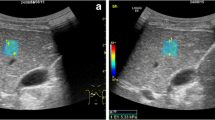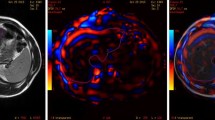Abstract
Purpose
Evaluate the effect of breath holding at the end of the inspiration and expiration phases on the measurement of liver stiffness by 2D-MR elastography (MRE).
Methods
The study included 61 subjects, of which 31 subjects were pathologically confirmed liver fibrosis patients [liver fibrosis group (LFG)] and 30 healthy subjects [healthy group (HG)]. MRE was used to measure the liver stiffness of subjects in inspiration breath-hold (IBH) and expiration breath-hold (EBH) states.
Results
In IBH and EBH states, the liver stiffness measured by MRE was not significantly different in the HG (P = 0.125, > 0.05), while the LFG showed a significant difference (P <0.001). Also, a significant difference was observed between the change values in the mild/moderate fibrosis group (MFG) and advanced fibrosis group (AFG) (P = 0.005, < 0.05).
Conclusions
The liver stiffness values in patients with liver fibrosis were affected by breath-holding states. The higher the stage of liver fibrosis, the greater the change in liver stiffness values, but no significant difference was observed between liver stiffness values in healthy subjects under the two breath-holding conditions. Different breath-holding states are factors influencing liver fibrosis stiffness measured by MRE, which should be given due attention in both clinical and research contexts.







Similar content being viewed by others
Data availability
The datasets used during the current study are available from the corresponding author on reasonable request.
References
Pellicoro A, Ramachandran P, Iredale JP, Fallowfield JA. Liver fibrosis and repair: immune regulation of wound healing in a solid organ. Nat Rev Immunol. 2014;14(3):181–194. https://doi.org/10.1038/nri3623
Trautwein C, Friedman SL, Schuppan D, Pinzani M. Hepatic fibrosis: Concept to treatment. J Hepatol. 2015;62(1 Suppl):S15–S24. https://doi.org/10.1016/j.jhep.2015.02.039
Marcellin P, Gane E, Buti M, et al. Regression of cirrhosis during treatment with tenofovir disoproxil fumarate for chronic hepatitis B: a 5-year open-label follow-up study. Lancet. 2013;381(9865):468–475. https://doi.org/10.1016/S0140-6736(12)61425-1
Lassailly G, Caiazzo R, Buob D, et al. Bariatric Surgery Reduces Features of Nonalcoholic Steatohepatitis in Morbidly Obese Patients. Gastroenterology. 2015;149(2):379‐e16. https://doi.org/10.1053/j.gastro.2015.04.014
Gonzalez HC, Jafri SM, Gordon SC. Role of liver biopsy in the era of direct-acting antivirals. Curr Gastroenterol Rep. 2013;15(2):307. https://doi.org/10.1007/s11894-012-0307-z
Gilmore IT, Burroughs A, Murray-Lyon IM, Williams R, Jenkins D, Hopkins A. Indications, methods, and outcomes of percutaneous liver biopsy in England and Wales: an audit by the British Society of Gastroenterology and the Royal College of Physicians of London. Gut. 1995;36(3):437–441. https://doi.org/10.1136/gut.36.3.437
Hennedige TP, Wang G, Leung FP, et al. Magnetic Resonance Elastography and Diffusion Weighted Imaging in the Evaluation of Hepatic Fibrosis in Chronic Hepatitis B. Gut Liver. 2017;11(3):401–408. https://doi.org/10.5009/gnl16079.
Besa C, Wagner M, Lo G, et al. Detection of liver fibrosis using qualitative and quantitative MR elastography compared to liver surface nodularity measurement, gadoxetic acid uptake, and serum markers. J Magn Reson Imaging. 2018;47(6):1552–1561. https://doi.org/10.1002/jmri.25911.
Choi YR, Lee JM, Yoon JH, Han JK, Choi BI. Comparison of magnetic resonance elastography and gadoxetate disodium-enhanced magnetic resonance imaging for the evaluation of hepatic fibrosis. Invest Radiol. 2013;48(8):607–613. https://doi.org/10.1097/RLI.0b013e318289ff8f
Kim D, Kim WR, Talwalkar JA, Kim HJ, Ehman RL. Advanced fibrosis in nonalcoholic fatty liver disease: noninvasive assessment with MR elastography. Radiology. 2013;268(2):411–419. https://doi.org/10.1148/radiol.13121193
Loomba R, Wolfson T, Ang B, et al. Magnetic resonance elastography predicts advanced fibrosis in patients with nonalcoholic fatty liver disease: a prospective study [published correction appears in Hepatology. 2015 Nov;62(5):1646]. Hepatology. 2014;60(6):1920–1928. https://doi.org/10.1002/hep.27362
Batheja M, Vargas H, Silva AM, et al. Magnetic resonance elastography (MRE) in assessing hepatic fibrosis: performance in a cohort of patients with histological data. Abdom Imaging. 2015;40(4):760–765. https://doi.org/10.1007/s00261-014-0321-8
Yoshimitsu K, Mitsufuji T, Shinagawa Y, et al. MR elastography of the liver at 3.0 T in diagnosing liver fibrosis grades; preliminary clinical experience. Eur Radiol. 2016;26(3):656–663. https://doi.org/10.1007/s00330-015-3863-4
Venkatesh SK, Talwalkar JA. When and how to use magnetic resonance elastography for patients with liver disease in clinical practice. Am J Gastroenterol. 2018;113(7):923–926. https://doi.org/10.1038/s41395-018-0012-0
Srinivasa Babu A, Wells ML, Teytelboym OM, et al. Elastography in Chronic Liver Disease: Modalities, Techniques, Limitations, and Future Directions. Radiographics. 2016;36(7):1987–2006. https://doi.org/10.1148/rg.2016160042
Castera L, Foucher J, Bernard PH, et al. Pitfalls of liver stiffness measurement: a 5-year prospective study of 13,369 examinations. Hepatology. 2010; 51:828–835. [PubMed: 20063276]
Zhuo J, Gullapalli RP. AAPM/RSNA physics tutorial for residents: MR artifacts, safety, and quality control. Radiographics. 2006;26(1):275–297. https://doi.org/10.1148/rg.261055134
Yin M, Talwalkar JA, Glaser KJ, et al. Dynamic postprandial hepatic stiffness augmentation assessed with MR elastography in patients with chronic liver disease. AJR Am J Roentgenol. 2011;197(1):64–70. https://doi.org/10.2214/AJR.10.5989
Mueller S. Does pressure cause liver cirrhosis? The sinusoidal pressure hypothesis. World J Gastroenterol. 2016;22(48):10482–10501. https://doi.org/10.3748/wjg.v22.i48.10482
Asbach P, Klatt D, Hamhaber U, et al. Assessment of liver viscoelasticity using multifrequency MR elastography. Magn Reson Med. 2008;60(2):373–379. https://doi.org/10.1002/mrm.21636
Huwart L, van Beers BE. MR elastography. Gastroenterol Clin Biol. 2008;32(6 Suppl 1):68–72. https://doi.org/10.1016/S0399-8320(08)73995-2
Yin M, Chen J, Glaser KJ, Talwalkar JA, Ehman RL. Abdominal magnetic resonance elastography. Top Magn Reson Imaging. 2009;20(2):79–87. https://doi.org/10.1097/RMR.0b013e3181c4737e
Murphy IG, Graves MJ, Reid S, et al. Comparison of breath-hold, respiratory navigated and free-breathing MR elastography of the liver. Magn Reson Imaging. 2017;37:46–50. https://doi.org/10.1016/j.mri.2016.10.011
Altinkaya N, Koc Z, Ulusan S, Demir S, Gurel K. Effects of respiratory manoeuvres on hepatic vein Doppler waveform and flow velocities in a healthy population. Eur J Radiol. 2011;79(1):60–63. https://doi.org/10.1016/j.ejrad.2010.01.011
Richardson PD, Withrington PG. Liver blood flow. I. Intrinsic and nervous control of liver blood flow. Gastroenterology. 1981;81(1):159–173.
Kleiner DE, Brunt EM, Van Natta M, et al. Design and validation of a histological scoring system for nonalcoholic fatty liver disease. Hepatology. 2005;41(6):1313–1321. https://doi.org/10.1002/hep.20701
Bedossa P, Poynard T. An algorithm for the grading of activity in chronic hepatitis C. The METAVIR Cooperative Study Group. Hepatology. 1996;24(2):289–293. https://doi.org/10.1002/hep.510240201
Bunt EM, Janney CG, Di Bisceglie AM, Neuschwander-Tetri BA, Bacon BR. Nonalcoholic steatohepatitis: a proposal for grading and staging the histological lesions. Am J Gastroenterol. 1999;94(9):2467–2474. https://doi.org/10.1111/j.1572-0241.1999.01377.x
Kleiner DE, Brunt EM. Nonalcoholic fatty liver disease: pathologic patterns and biopsy evaluation in clinical research. Semin Liver Dis. 2012;32(1):3–13. https://doi.org/10.1055/s-0032-1306421
Silva AM, Grimm RC, Glaser KJ, et al. Magnetic resonance elastography: evaluation of new inversion algorithm and quantitative analysis method. Abdom Imaging. 2015;40(4):810–817. https://doi.org/10.1007/s00261-015-0372-5
Trout AT, Serai S, Mahley AD, et al. Liver Stiffness Measurements with MR Elastography: Agreement and Repeatability across Imaging Systems, Field Strengths, and Pulse Sequences. Radiology. 2016;281(3):793–804. https://doi.org/10.1148/radiol.2016160209
Faul F, Erdfelder E, Lang AG, Buchner A. G*Power 3: a flexible statistical power analysis program for the social, behavioral, and biomedical sciences. Behav Res Methods. 2007;39(2):175–191. https://doi.org/10.3758/bf03193146
Rabinovici N, Navot N. The relationship between respiration, pressure and flow distribution in the vena cava and portal and hepatic veins. Surg Gynecol Obstet. 1980;151(6):753–763.
Millonig G, Friedrich S, Adolf S, et al. Liver stiffness is directly influenced by central venous pressure. J Hepatol. 2010;52(2):206–210. https://doi.org/10.1016/j.jhep.2009.11.018.
Wang K, Manning P, Szeverenyi N, et al. Repeatability and reproducibility of 2D and 3D hepatic MR elastography with rigid and flexible drivers at end-expiration and end-inspiration in healthy volunteers. Abdom Radiol (NY). 2017;42(12):2843–2854. https://doi.org/10.1007/s00261-017-1206-4
Yang YL, Di L, Duan YY, et al. A prospective experimental study of liver fibrosis with ultrasound and its correlation with hepatic reserve function and hemodynamics. BMC Gastroenterol. 2012;12:168. Published 2012 Nov 23. https://doi.org/10.1186/1471-230X-12-168
Acknowledgements
This work was supported by a Grant from the National Natural Science Foundation of China (No. 61871276).
Funding
National Natural Science Foundation of China (No. 61871276) National Science and Technology Major Project (2017ZX0203202-003).
Author information
Authors and Affiliations
Corresponding author
Ethics declarations
Conflict of interest
The authors declare that they have no conflict of interest.
Ethical approval
All procedures in this study were in accordance with the Ethical Standards of the Institutional Research Committee and with the 1964 Helsinki Declaration and its later amendments or comparable ethical standards.
Informed consent
Written informed consent was obtained from individual or guardian participants.
Consent for publication
Written informed consent for publication was obtained from all participants.
Additional information
Publisher's Note
Springer Nature remains neutral with regard to jurisdictional claims in published maps and institutional affiliations.
Rights and permissions
About this article
Cite this article
Ren, H., Yang, D., Xu, H. et al. Effect of breath holding at the end of the inspiration and expiration phases on liver stiffness measured by 2D-MR elastography. Abdom Radiol 46, 2516–2526 (2021). https://doi.org/10.1007/s00261-020-02893-w
Received:
Revised:
Accepted:
Published:
Issue Date:
DOI: https://doi.org/10.1007/s00261-020-02893-w




